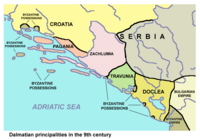Travunias
Travunia ( Latin Tribunia ) is a historical landscape in the south of today's Herzegovina and Dalmatia . The center was today's city of Trebinje .
history
In the 10th century, the Byzantine emperor and historian Constantine VII also described the area of today's Herzegovina in his De Administrando Imperio . In the east of today's Herzegovina he calls the duchy “Travunia”, which also included parts of today's northern Montenegro , and the capital Tervunia , today's Trebinje. According to Constantine , its inhabitants were Serbs who settled there at the time of Herakleios . Medieval writers often equated “Serbs” with the Slavs as a whole, as a Slavic original tribe or umbrella term for all Slavs. The Duchy of Travunia has belonged to Serbia since the 9th century . Important Serbian ruling dynasties came from Travunia, such as the Vojisavljević , founder of the first Serbian kingdom, or the Mrnjavčević , co-regents of the last Serbian tsar Stefan Uroš V.
With the collapse of the Serbian Empire , Prince Nikola Altomanović established himself in Travunia , who claimed the Serbian tsar's crown for himself. Nikola Altomanović conquered large areas in western central Serbia before he was defeated in 1373 by a joint action of the Bosnian prince and later king Tvrtko I and the Serbian prince Lazar and his territory was divided between the victors.
Travunia together with the city of Trebinje fell to Bosnia . In the 15th century, until the conquest by the Ottomans, the voivode Stjepan Vukčić Kosača and his descendants ruled what is now Herzegovina and northern Montenegro. Stjepan Vukčić Kosača founded his capital in Mostar , but Trebinje nonetheless remained an important post on the trade route from Dubrovnik to the interior of Bosnia and Serbia. The Orthodox monastery Tvrdoš, which became the seat of the Serbian Orthodox Bishop for Herzegovina, also came from this time .
Individual evidence
- ^ De administrando imperio Vol. II, Commentary / by F. Dornik and others; ed. by RJH Jenkins. London, The Athlone Press, 1962, pp. 139ff. and 160ff.
- ^ Heinrich Kunstmann : The Slaves. Her name, her migration to Europe and the beginnings of Russian history from a historical and onomastic point of view. Steiner, Stuttgart 1996, ISBN 3-515-06816-3 , p. 125.

